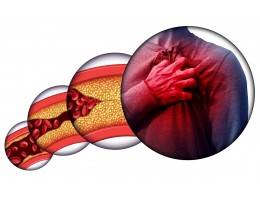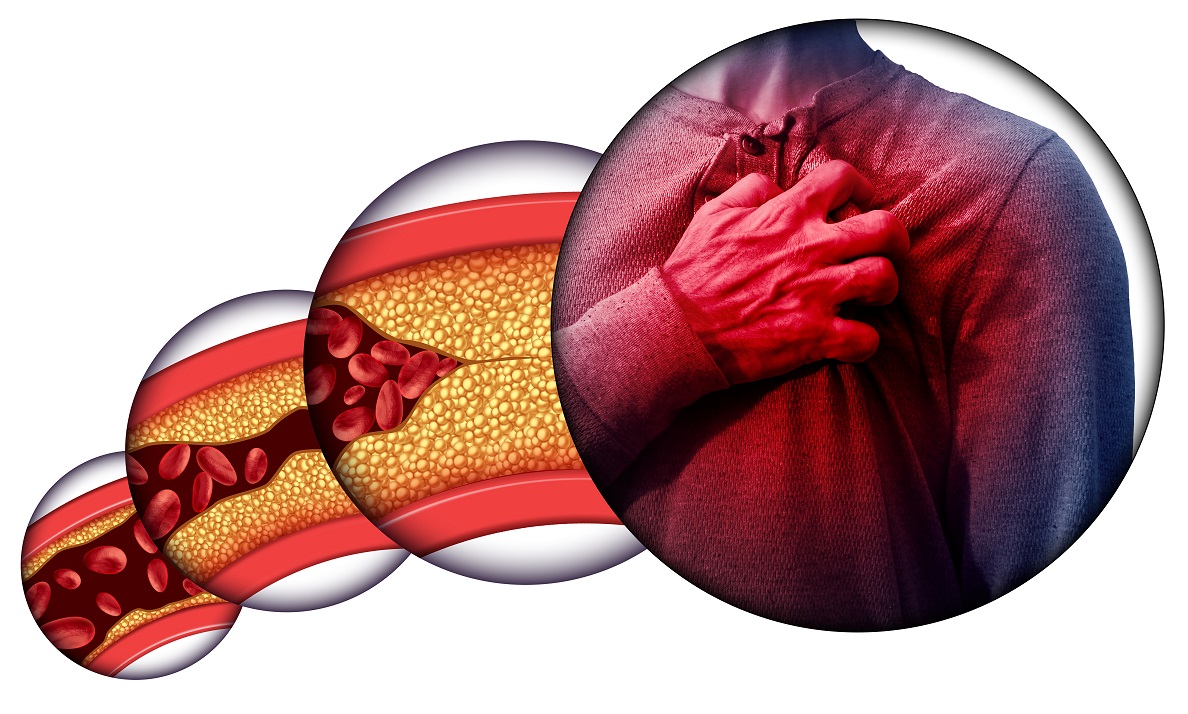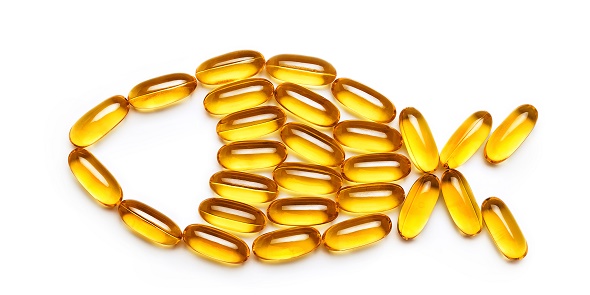Cholesterol is a type of lipid. It is a waxy, fat-like substance that liver produces naturally. It is vital for the formation of cell membranes, certain hormones (estrogen & testosterone), vitamin D and bile acid.
However, too much of cholesterol can combine with other substances in the blood to form plaque. Plaque sticks to the walls of the arteries causing atherosclerosis. This leads to coronary artery disease, heart attack or stroke due to blockage or narrowing of the arteries.
There are two types of lipoproteins that carry cholesterol to and from cells, which are low-density lipoprotein (LDL) and high-density lipoprotein (HDL).
Types of cholesterol
- LDL (bad) cholesterol
LDL cholesterol is considered the “bad” cholesterol, because it contributes to fatty build-ups in the arteries (atherosclerosis). This narrows the arteries and increases the risk for heart attack, stroke and peripheral artery disease.
- HDL (good) cholesterol
HDL cholesterol can be thought of as the “good” cholesterol because a healthy level of HDL in the blood may protect us against heart attack and stroke.
HDL also carries LDL (bad) cholesterol away from the arteries and back to the liver, where the LDL will be broken down and passed out from the body. But HDL cholesterol doesn’t completely eliminate LDL cholesterol. Only one-third to one-fourth of blood cholesterol is carried by HDL.
- Triglycerides
Triglycerides are the most common type of fat in the body. They store excess energy from your diet.
A high triglyceride level combined with high LDL (bad) cholesterol or low HDL (good) cholesterol is often linked with fatty build-up within the artery walls, which increases the risk of heart attack and stroke.
Symptoms
High cholesterol levels do not usually cause any symptoms. In most cases it only causes emergency events. For instances, angina (chest pain), high blood pressure, stroke or a soft, yellowish growths or lesions on the skin called xanthomas, fatigue, weight gain, stomach distention and aching pain.
Risk factor
- Age
- Overweight or obese
- Unhealthy eating habits
- Lack of physical activity
- Smoking
- Have a family history of high cholesterol
- Have diabetes, high blood pressure
Treatment of Hypercholesterolemia
- HMG CoA Reductase Inhibitors (Statins)
Statin lowers LDL-cholesterol level by reducing the liver’s production of cholesterol and improve liver’s ability to remove LDL-cholesterol that is already in the blood. It is the first line agent in treating hypercholesterolemia.
Statin should be taken at night. It is contraindicated in pregnancy, lactation, women of child bearing potential and liver failure patient. The most common side effects of statin are muscle aches, gastrointestinal discomfort, headache.
Examples: Simvastatin, lovastatin, atorvastatin and rosuvastatin.
- Cholesterol Absorption Inhibitors
Cholesterol absorption inhibitors selectively blocks intestinal absorption of both dietary and biliary cholesterols and other phytosterols thus reducing the amount of cholesterol that travel from intestine to liver, lowering the amount of cholesterol stored in the liver and hence increasing the amount of cholesterol that can be cleared from the blood.
It can be used in combination with any dose of any statin to further lowering LDL-C if targets are not achieved. Besides, it may be considered as monotherapy in patients who cannot tolerate statins.
There is no major adverse effects have been reported. The most frequent adverse effects are stomachache, diarrhea, headache, fatigue, muscle aches.
Example: Ezetimibe
- Fibric Acid Derivatives (Fibrates)
Fibrates are Peroxisome Proliferator Activated Receptor (PPAR) – α agonist which have an important role in fatty acid oxidation. They reduce serum TG effectively and increase HDL-C modestly. It is limited to the treatment in patient with very high TG levels.
Common side effects are gastrointestinal discomfort, flushing of the skin, dizziness, headache.
Example: fenofibrate (take with meal and swallow whole with water), gemfibrozil (take 30mins before meal)
- PCSK9 Inhibitors
PCSK9 inhibitors are a new class of drugs that lower LDL. It works by inhibiting the binding of PCSK9 to the LDL-receptors. Currently, it is only available as an injection administered subcutaneously at 2-4 weeks intervals. Common side effects are injection-site swelling, flu-like symptoms, nausea and joint pains.
Example: evolocumab, alirocumab
Nutritional Supplements for High Triglycerides and Cholesterol
- Red yeast rice
Red yeast rice is a type of fermented rice. It contains monacolin k, a naturally substance that is similar to lovastatin. Thus, it is able to lower the cholesterol. Studies show that it is able to reduce 22% of cholesterol after about 8weeks of consuming it.
- Fish oil
Fish oil is polyunsaturated fatty acids (PUFA) that only comes from food like herring, mackerel, salmon etc. It is available in liquid or soft gel form. Omega-3 fatty acid in fish oil is able to reduce triglycerides level, prevent the formation of harmful blood clots and improve heart health.
- Oat beta glucan
It is a soluble dietary fibre that will form viscous gel in the stomach before entering the intestines. The gel will then attach to bile acid and remove them from the body. Body will then use more cholesterol to reproduce bile thereby reducing cholesterol in the body.
- Flaxseed oil
Flaxseed oil contains alpha linoleic acid (ALA), a form of omega 3 fatty acids that is found in walnut, flaxseed and chiaseed. It is used to lower the cholesterol level by reducing the LDL-C. Flaxseed oil is available in liquid or softgel form. It is suitable for vegetarian.
- Lecithin
Lecithin is a type of fat that can be found naturally in many foods that’s essential to human health. Most lecithin supplements are made from soybeans. Phosphatidylcholine, a major component of lecithin is responsible for lecithin’s reported health benefits. It is able to reduce LDL and may also raise the level of HDL.
- Coenzyme Q10 (CoQ10)
CoQ10 is an antioxidant naturally produced by the body that is essential for cellular energy production in mitochondria by converting food into energy. It aids in lowering cholesterol and improving heart health. Cholesterol-lowering statin drugs can reduce CoQ10 production in body, hence CoQ10 supplements are important to restore CoQ10 levels in the body and also to reduce statin side effects (like muscle aches).
- Probiotics
Probiotics are groups of beneficial bacteria that our body needed for good health and vitality. Probiotics, particularly Lactobacilli plantarum and lactobacilli reuteri can help to reduce cholesterol level by binding with the cholesterol in the intestine to stop it from being absorbed and also produce short-chain fatty acids to prevent cholesterol from being formed by the liver. Probiotics also produce bile acids that help to metabolize fat and cholesterol in the body.
Lifestyle modification
- Have a healthy diet
Reduce the intake of saturated fats and trans fat like red meat and dairy products that are made with whole milk. Choose skim milk, low fat or fat-free dairy products instead. Limit fried food and cook with vegetable oils like sunflower oil, olive oil. Consume more leafy vegetables, fruits and whole grains. Always choose to prepare food at home and if having meals outside; choose food with that is grilled, steamed or boiled.
- Become more physically active
A sedentary lifestyle lowers the level of HDL cholesterol. Less HDL means there’s less good cholesterol to remove bad cholesterol from the arteries. Hence, physical activity is important. It is recommended to exercise 30-45mins per session at least 5 times a week to improve cardiovascular fitness, raise HDL-C and decrease triglycerides level. Aerobic exercise like brisk walking, jogging, cycling and swimming are recommended.
- Quit smoking
Smoking can lower HDL cholesterol. A person with unhealthy cholesterol levels who also smokes will have increased risk of coronary heart disease. By quitting, smokers not only can lower their LDL cholesterol and increase HDL cholesterol but also can help to protect their arteries.
- Restrict alcohol intake
Alcohol is the macronutrient that contributes to the increase in serum triglycerides. In a person with elevated serum triglycerides, excess alcohol consumption can further exacerbate hyperlipidemia. Thus, alcohol consumption should be restricted to not more than 14 units for male and 7 units for female per week. * 1unit = 250ml of beer = 100ml of wine = 30ml of whiskey
- Weight reduction
Being overweight or obese is linked with increased level of bad cholesterol and decreased level of good cholesterol in the body. A weight loss of 5-10 % is able to enhance total cholesterol and LDL-cholesterol lowering effects, at the same time increase HDL-cholesterol. Therefore, it is important to maintain at normal bodyweight. Recommended BMI for Asians is 18.5kg/m2 –23kg/m2.
References
- Everything You Need to Know About High Cholesterol. Available from https://www.healthline.com/health/high-cholesterol
- Cholesterol. Available from https://medlineplus.gov/cholesterol.html
- HDL (Good), LDL (Bad) Cholesterol and Triglycerides. Available from https://www.heart.org/en/health-topics/cholesterol/hdl-good-ldl-bad-cholesterol-and-triglycerides
- Understanding Cholesterol Numbers. Available from https://www.webmd.com/cholesterol-management/guide/understanding-numbers
- Understanding Cholesterol Problems: Symptoms. Available from https://www.webmd.com/cholesterol-management/guide/understanding-cholesterol-problems-symptoms
- High Cholesterol Risk Factors. https://www.webmd.com/cholesterol-management/high-cholesterol-risk-factors
- 5th edition of clinical practice guideline : Management of dyslipidemia 2017.
- Thu Nguyen, Mitchell Karl and Antonello Santini (2017) : Red yeast Rice
- Yuka Kawakami, Hisami Yamanaka-Okumura, Yuko Naniwa-Kuroki, Masae Sakuma, Yutaka Taketani & Eiji Takeda (2015) : Flaxseed oil intake reduces serum small dense low-density lipoprotein concentrations in Japanese men: a randomized, double blind, crossover study
- Amouni Mohamed Mourad, Eder de Carvalho Pincinato, Priscila Gava Mazzola, Maricene Sabha, Patricia Moriel, “Influence of Soy Lecithin Administration on Hypercholesterolemia”, Cholesterol, vol. 2010, Article ID 824813, 4 pages, 2010.
- Robertson R. Do Probiotics Benefit Heart Health? [Internet]. Healthline. 2018 [cited 18 October 2021]. Available from: https://www.healthline.com/nutrition/probiotics-and-heart-health
- Prevention and Treatment of High Cholesterol (Hyperlipidemia) [Internet]. www.heart.org. 2020 [cited 18 October 2021]. Available from: https://www.heart.org/en/health-topics/cholesterol/prevention-and-treatment-of-high-cholesterol-hyperlipidemia



-260x200.jpg)
.jpg)




-260x200.jpg)
.jpg)
/the-dash-diet-1-638.jpg)
/low-sodium-diet-cover-adobe-1600x900-1-768x432.jpeg)
/noAlcoholSafe-481329705-650x450-650x428-1.jpg)
/Norway-reduces-sugar-consumption-768x432.jpg)



